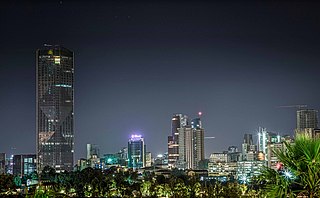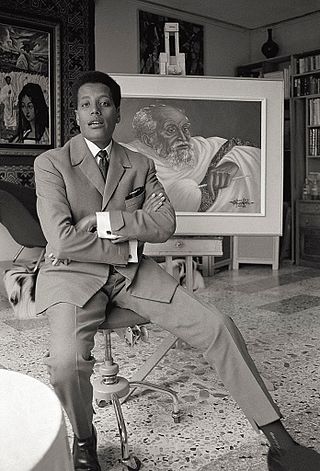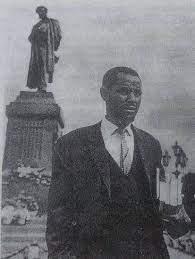
Addis Ababa is the capital and largest city of Ethiopia. In the 2007 census, the city's population was estimated to be 2,739,551 inhabitants. Addis Ababa is a highly developed and important cultural, artistic, financial and administrative centre of Ethiopia.

Addis Ababa University (AAU) is a national university located in Addis Ababa, Ethiopia. It is the oldest university in Ethiopia. AAU has thirteen campuses. Twelve of these are situated in Addis Ababa, and one is located in Bishoftu, about 45 kilometres (28 mi) away. AAU has several associated research institutions including the Institute of Ethiopian Studies. The Ministry of Education admits qualified students to AAU based on their score on the Ethiopian University Entrance Examination (EUEE).

Afewerk Tekle was an Ethiopian artist, particularly known for his paintings on African and Christian themes as well as his stained glass.
Orchestra Ethiopia was an Ethiopian concert band formed in 1963 by the Egyptian-born American composer and ethnomusicologist Halim El-Dabh. The group, which was founded in Addis Ababa, comprised up to 30 traditional instrumentalists, vocalists, and dancers from many different Ethiopian regions and ethnic groups. It was the first ensemble of its type, as these diverse instruments and ethnic groups previously had never played together. For a time, due to El-Dabh's efforts, the Orchestra was in residence at the Creative Arts Centre of Haile Selassie I University.

The Kebur Zebenya was the Ethiopian imperial guard. Also known as the First Division, this unit served the dual purposes of providing security for the Emperor of Ethiopia, and being an elite infantry division. It was not, however, part of the organizational structure of the Ethiopian regular army as it was part of the Zebagna, the Addis Ababa Guard. The Kebur Zabagna was based in Addis Ababa.

Alexander "Skunder" Boghossian was an Ethiopian-Armenian painter and art teacher. He spent much of his life living and working in the United States. He was one of the first, and by far the most acclaimed, contemporary Black artists from the African continent to gain international attention.
Kebedech Tekleab is an Ethiopian painter, sculptor, and poet.
Agegnehu Engida, was an Ethiopian modern painter. He blended abstraction, expressionism, and surrealism, but maintained a style that was "distinctively Ethiopian."

Berhanu Zerihun was an Ethiopian writer in Amharic and journalist, noted for his clear and crisp writing style, which contrasted against the more complex writing style popular in his time.
Michael Tsegaye is an Ethiopian artist and photographer. Much of his work presents a glimpse of life in contemporary Ethiopia, although an extended catalogue of his images come from his travels abroad.
Gebre Kristos Desta, also known as Gebrekristos Desta, was an Ethiopian painter and poet. He is credited with bringing modern art to Ethiopia Both his paintings and poems stirred controversy among his countryfolk. He died young, at age fifty as a refugee living in the United States, but despite his short life he transformed Ethiopian art influenced many a young artist.
Abel Tilahun is an Ethiopian artist and filmmaker, who works across traditional and emerging art forms. At the heart of his work is a concern for both the cutting edge and the long arc of history.
The Imperial Academy was the national academy of Ethiopia, first established by the Ministry of Education and Fine Arts in 1942. It was tasked with preserving the "traditional genius" of the country; among other things, the native Ethiopic script and the literary and scholarly tradition it enabled, as well as the "promotion of research in languages and fine arts".
Klaus Mertens is a German contemporary artist. He is currently residing in Berlin and Addis Ababa.
Salem Mekuria is an Ethiopian-born independent filmmaker, video artist and educator living in the United States.

Yadesa Bojia is a Seattle-based Ethiopian graphic designer and artist. Bojia has exhibited regionally since 2006. In 2010, he rose to international acclaim when his design was selected for the African Union's flag. Bojia has shown his work in exhibitions, completed commissioned works, and given public talks about the themes of his work, including human rights, minority rights, Africa, and justice. Bojia's style as a painter draws on African impressionism.
The Skunder Boghossian College of Performing and Visual Arts is the umbrella organization for Ethiopia's oldest secular schools for the arts, offering Bachelors and Masters programs in art, theater, and music.
Tesfaye Geleta Urgessa is an Ethiopian-born painter. He is from Addis Ababa, and has been based in Germany since 2009.
Ale Felege Selam Heruy was an Ethiopian painter, educator, and school founder. He founded the Addis Ababa School of Art in 1957, renamed in his honor to Ale School of Fine Arts and Design.
Dawit Abebe is an Ethiopian contemporary artist who has impacted the art world with his visually striking and thought-provoking works. Dawit's goal as an artist is to raise awareness of Addis Ababa's contemporary art scene as well as its society and history. He believes that in order for humans to progress, it is essential that a nation and its citizens understand how the past has shaped present life through his art.






